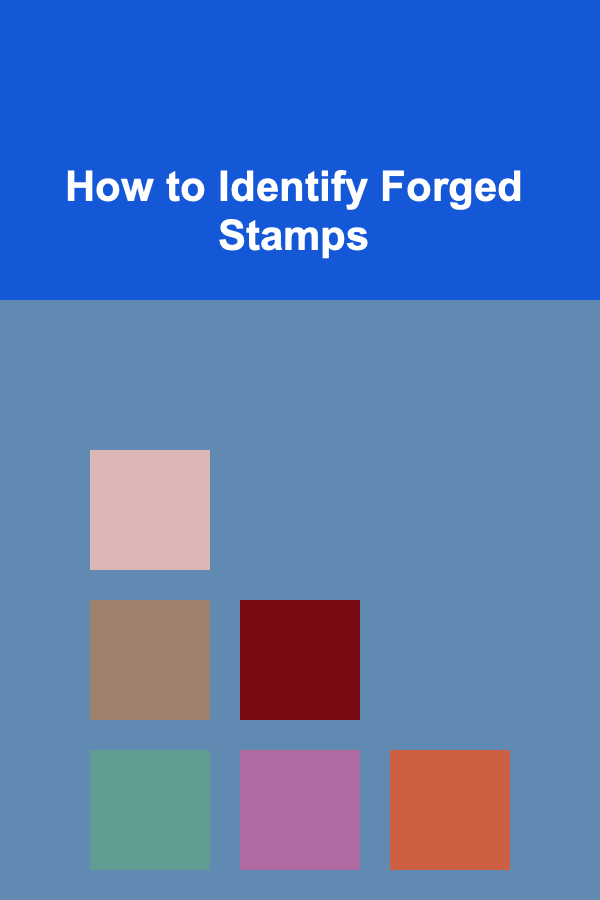
How to Identify Forged Stamps
ebook include PDF & Audio bundle (Micro Guide)
$12.99$11.99
Limited Time Offer! Order within the next:

Stamp collecting, also known as philately, is a fascinating hobby enjoyed by millions worldwide. For collectors, stamps can be valuable items that hold both historical and financial significance. However, as the value of stamps increases, so does the number of forgeries entering the market. Whether you're a seasoned collector or a novice, it is crucial to know how to identify forged stamps to protect your collection from fraudulent activity.
In this article, we will delve into the methods and techniques for identifying forged stamps, providing you with the tools and knowledge you need to avoid being duped. From understanding the types of forgeries to recognizing specific signs of a fake, this guide will cover all the critical aspects of identifying forged stamps.
Understanding the Types of Stamps and Their Forged Counterparts
Before diving into identification techniques, it's essential to understand the different types of stamps and the forgeries associated with them.
Genuine Stamps
Genuine stamps are issued by postal authorities and are designed with security features to make them difficult to forge. They may include intricate designs, watermarks, perforations, and specific printing techniques.
Types of Forged Stamps
Forged stamps are typically classified into three main categories:
- Fake Stamps: These are entirely counterfeit and resemble the genuine stamp. The designs, colors, and inscriptions are copied, and the stamp may be printed using various methods, such as offset or lithography.
- Reprinted Stamps: Reprints involve printing genuine stamps after they have been issued, but the stamps are not legitimate because they were printed after the fact. While they may look identical to genuine stamps, they have no postal validity.
- Altered Stamps: In these forgeries, a genuine stamp is altered to increase its perceived value. For example, a used stamp might be cleaned and re-canceled, or a lower-value stamp may be altered to appear as a rarer version.
Each type of forgery requires a different approach for identification.
Recognizing the Signs of Forgery
Recognizing forged stamps can be challenging because counterfeiters are becoming increasingly sophisticated. However, by paying attention to the details, you can spot the differences. Here are some of the key signs to look out for:
Print Quality and Color
Genuine stamps are printed using advanced techniques that give them a sharp, clear image. The color used in genuine stamps is also precise and consistent across printings. Forged stamps often have noticeable differences in quality:
- Blurry or Smudged Print: The image on a forged stamp might appear fuzzy or lack sharp edges. Genuine stamps, particularly older ones, have fine lines and intricate details.
- Color Differences: Counterfeit stamps may have a slight difference in color, either appearing too dark or too light compared to an authentic stamp. Some forgeries may also use a different type of ink.
Paper Quality
Genuine stamps are printed on specific types of paper that give them a distinct texture. Forged stamps may not replicate this texture accurately. Look for the following characteristics:
- Thickness: Genuine stamp paper has a certain thickness, while forgeries may use cheaper, thinner paper.
- Texture and Feel: Many genuine stamps have a unique texture, especially older stamps that are printed on coated or specialized paper. If the paper feels unusually smooth or rough, it could be a sign of a forgery.
- Watermarks: Some stamps, particularly older or high-value ones, have watermarks embedded in the paper for security. These watermarks can sometimes be seen when the stamp is held up to light. Counterfeit stamps may lack a watermark or have a poorly replicated one.
Perforations
The perforation of a stamp---the small holes that separate it from others on the sheet---is a crucial detail to consider when identifying forgeries. Genuine stamps are perforated with precision, creating evenly spaced, sharp perforation holes.
- Uneven Perforations: A counterfeit stamp may have uneven, irregular perforations. The holes might be too large or too small, or the spacing between them may be inconsistent.
- No Perforations: Some forgers may print the stamp without perforating it, making it appear as a single piece of paper. In these cases, you can often spot the lack of perforations by examining the edges of the stamp.
- Imperforate Stamps: While some stamps were intentionally printed without perforations, others may be forged to appear as such. Ensure you are familiar with the genuine imperforate stamps of that era to avoid confusion.
Gum and Adhesive
The adhesive used on genuine stamps is also an important distinguishing feature. Older stamps may have gum that is slightly yellowed or discolored with age, while modern stamps have a more consistent, transparent adhesive.
- Lack of Gum: Forgeries sometimes omit the gum altogether or use inferior adhesive that is easy to peel off.
- Incorrect Gum Texture: The gum on forged stamps may be too thick, too thin, or have a different texture compared to genuine stamps.
Cancelations
If a stamp has been used, it will typically have a cancellation mark, often in the form of a postmark. The cancelation is meant to prevent the stamp from being reused. However, counterfeiters sometimes remove or recreate cancellation marks.
- Inconsistent Cancelation: A poorly executed cancellation or a stamp that appears freshly cancelled on a stamp that should be older can indicate forgery. The date and location of the cancellation should match the postal system of the time.
- Reused Stamps: Some counterfeiters alter or clean used stamps to make them appear new or more valuable. Check for signs of tampering, such as traces of erasure or faded ink.
Tools for Identifying Forged Stamps
There are several tools and techniques that stamp collectors and dealers use to identify forged stamps more accurately. Some of the most useful tools include:
Magnifying Glass or Loupe
A magnifying glass, particularly a 10x loupe, is an essential tool for stamp collectors. Using a loupe allows you to closely examine the details of the stamp, such as the print quality, perforations, and any subtle flaws.
Ultraviolet (UV) Light
Many stamps have invisible markings that are revealed under UV light. Some stamps include security features such as UV ink that glows under specific wavelengths of light. Using a UV light can help you spot these hidden details, which are difficult to replicate in forgeries.
Watermark Detector
For stamps with watermarks, a watermark detector can be used to reveal the watermark embedded in the paper. These devices use light and specialized filters to expose the watermark without damaging the stamp.
Perforation Gauge
A perforation gauge is a tool that helps measure the perforations on a stamp. By using a perforation gauge, you can determine whether the perforations on a stamp match those of genuine stamps from the same series or period.
Microscope
A microscope can be used to examine the finer details of a stamp's print, paper, and cancelations. This tool is particularly useful for identifying counterfeit stamps with subtle flaws that would not be visible with a loupe or magnifying glass.
Consulting Experts and Reference Books
If you're ever in doubt about the authenticity of a stamp, it's always a good idea to consult an expert. Many philatelic societies, auction houses, and dealers can help you verify the authenticity of a stamp. Additionally, reference books, catalogs, and online databases can provide valuable information on specific stamps, including their known forgeries.
Philatelic Societies
Joining a philatelic society can provide you with access to a network of experienced collectors and experts who can help you spot forged stamps. Many societies also offer authentication services for rare or valuable stamps.
Stamp Catalogs
Comprehensive stamp catalogs, such as the Scott Standard Postage Stamp Catalogue, list all known stamps, including their variants, values, and known forgeries. They also provide images of genuine and forged stamps for comparison.
Avoiding Forged Stamps in the Market
While knowing how to identify forged stamps is crucial, it's equally important to avoid purchasing forgeries in the first place. Here are some tips for avoiding counterfeit stamps in the market:
- Buy from Reputable Dealers: Always purchase stamps from reputable dealers, auction houses, or philatelic societies. Ensure that the dealer provides guarantees of authenticity and offers certificates of authenticity when necessary.
- Avoid Buying Expensive Stamps Online: While online marketplaces can be convenient, they are also ripe for counterfeiters. Always buy expensive or rare stamps from trusted sources or through established auction houses.
- Ask for Certificates of Authenticity: When purchasing high-value stamps, request certificates of authenticity from recognized experts or certification organizations.
Conclusion
The art of identifying forged stamps requires knowledge, experience, and attention to detail. By understanding the characteristics of forged stamps, using the right tools, and consulting experts when necessary, you can significantly reduce the risk of acquiring fake stamps.
Whether you are just starting your stamp collection or you are an experienced philatelist, it is essential to remain vigilant and informed. With the right knowledge and resources, you can continue to enjoy the world of stamp collecting while avoiding the pitfalls of forgeries.
Reading More From Our Other Websites
- [Home Holiday Decoration 101] How to Decorate a Holiday Entryway to Wow Guests
- [Organization Tip 101] How to Use Seasonal Decor Without Overwhelming Buyers
- [Home Party Planning 101] How to Use Best Party Planning Websites to Delegate Tasks and Save Time for Your Next Home Celebration
- [Metal Stamping Tip 101] Why Metal Stamping Is the Secret Weapon for Small-Batch Manufacturers
- [Home Lighting 101] How to Add Glamour to Your Home with Crystal Lighting Fixtures
- [Organization Tip 101] How to Fix Common Tiling Issues and Ensure Long-Term Durability
- [Home Renovating 101] How to Create a Functional and Stylish Basement
- [Gardening 101] Best Vertical Gardening Systems: Maximizing Space for Urban Growers
- [Trail Running Tip 101] Layering Secrets: Building the Perfect Outfit for Rugged Trails
- [Organization Tip 101] How to Organize Lunchbox Essentials for Easy Packing

How to Budget for Big Life Events (Wedding, Baby, etc.)
Read More
How to Design a Retirement Planning Checklist for Downsizing or Relocating
Read More
How to Find Your Inner Wisdom
Read More
10 Tips for Managing IoT Device Deployment as an Architect
Read More
How to Build a Home Maintenance Checklist for Every Season
Read More
10 Creative Ways to Teach Kids About Budgeting
Read MoreOther Products

How to Budget for Big Life Events (Wedding, Baby, etc.)
Read More
How to Design a Retirement Planning Checklist for Downsizing or Relocating
Read More
How to Find Your Inner Wisdom
Read More
10 Tips for Managing IoT Device Deployment as an Architect
Read More
How to Build a Home Maintenance Checklist for Every Season
Read More